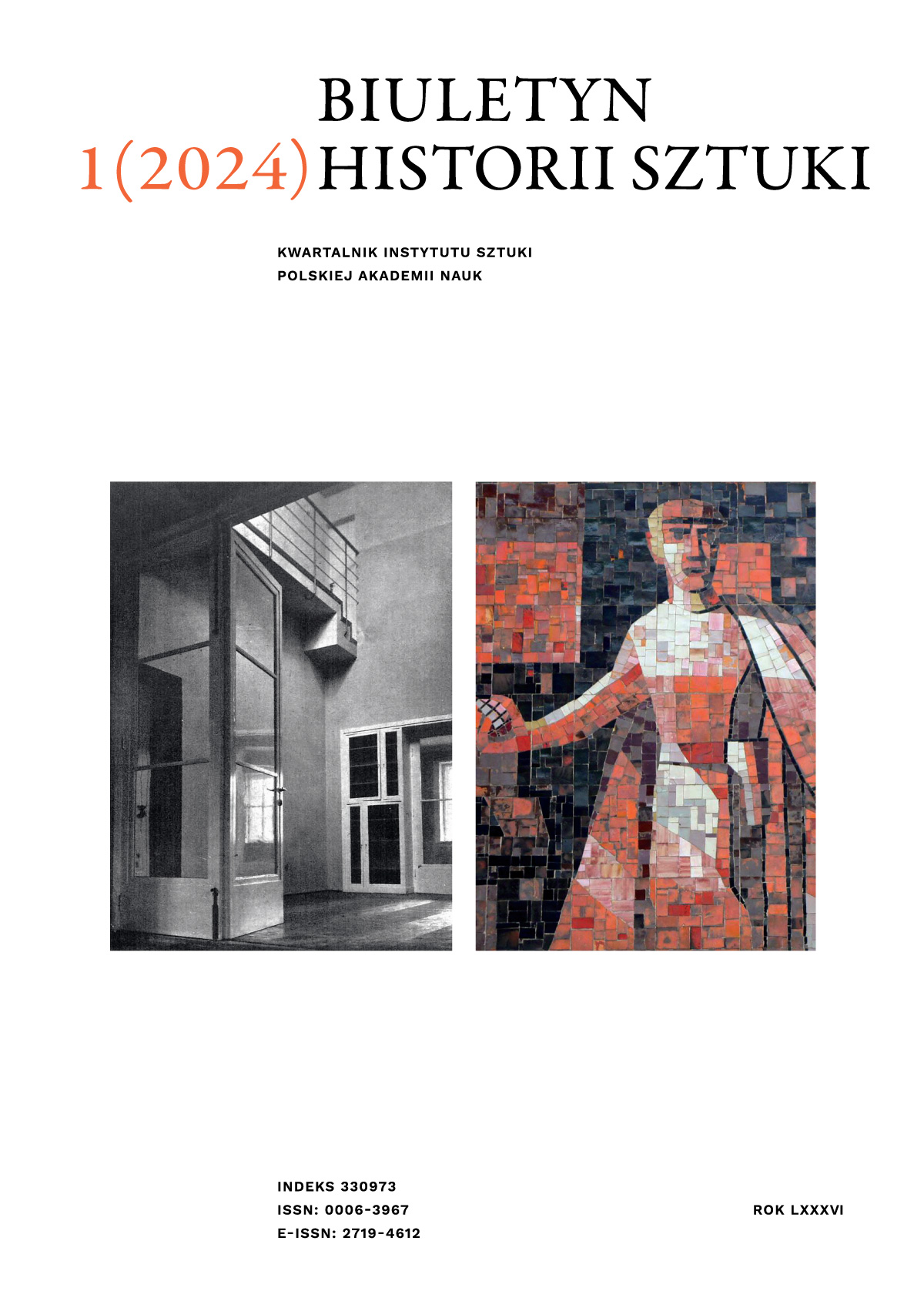“One of the Most Delightful Sights in Warsaw”. On the French Models for the Arcades and Colonnade of the Saxon Palace
Paweł Migasiewicz
p.migasiewicz@gmail.comInstitute of Art, Polish Academy of Sciences (Poland)
https://orcid.org/0000-0001-8610-8845
Abstract
The article is devoted to the origins of the general concept and detailed solutions applied in the new Saxon Palace in Warsaw, erected between 1838 and 1842 following the design by Wacław Ritschel and Adam Idźkowski. The most characteristic feature of the edifice was its division into two parts connected by arcades and a colonnade, which allowed communication between the square and the garden and between the two parts of the building. The text demonstrates that this solution is a compilation of several models drawn from 17th- and 18th-century French architecture, two of them in particular.
Keywords:
Warsaw, Saxon Palace, Wacław Ritschel, Adam Idźkowski, French architecture, Jean Marot, Marly, Grand Trianon, Jules-Hardouin-Mansart, Ange-Jacques GabrielReferences
Bergeret, Virginie. „Le pavillon de la Perspective à Marly. Un bâtiment central aux fonctions multiples”. Bulletin du Centre de recherche du château de Versailles 2014. Dostęp 6 grudnia 2023. https://doi.org/10.4000/crcv.12579.
DOI: https://doi.org/10.4000/crcv.12579
Google Scholar
Bernatowicz, Tadeusz. „Ogród i miasto. Z dziejów kształtowania się przestrzeni publicznej Osi Saskiej w XIX wieku”. W: Historyczne place Warszawy. Urbanistyka, architektura, problemy konserwatorskie. Materiały sesji naukowej, Warszawa, 3–4 listopada 1994, redakcja Bożena Wierzbicka, 96–104. Warszawa: Towarzystwo Opieki nad Zabytkami, 1995.
Google Scholar
Bieniecki, Zdzisław. „Oś barokowa Warszawy”. Kwartalnik Architektury i Urbanistyki 5, nr 4 (1960): 469–522.
Google Scholar
Borowska, Joanna. Niezwykła historia Pałacu Saskiego. Warszawa: Skarpa Warszawska, 2020.
Google Scholar
Castelluccio, Stéphane. Marly. Art de vivre et pouvoir de Louis XIV à Louis XVI. Montreuil: Gourcuff Gradenigo, 2014.
Google Scholar
Deutsch, Kristina. Jean Marot. Un graveur d’architecture à l’époque de Louis XIV. Berlin–Boston: De Gruyter, 2015.
DOI: https://doi.org/10.1515/9783110376760
Google Scholar
Hartmann, Claudia. „La création de Marly. Les rôles de Charles Le Brun, Jules Hardouin-Mansart et Louis XIV dans la conception de l’ensemble”. Bulletin du Centre de recherche du château de Versailles 5 (2012). Dostęp 6 grudnia 2023. https://doi.org/10.4000/crcv.12220.
DOI: https://doi.org/10.4000/crcv.12220
Google Scholar
Kwiatkowski, Marek. Stanisław August, król-architekt. Wrocław: Zakład Narodowy im. Ossolińskich, 1983.
Google Scholar
Le Guillou, Jean-Claude. „Avant la galerie des Glaces, un projet méconnu pour Versailles”. Versalia. Revue de la Société des Amis de Versailles 12 (2009): 97–112.
DOI: https://doi.org/10.3406/versa.2009.895
Google Scholar
Maroteaux, Vincent. „Château et jardins de Marly”. W: Jules Hardouin-Mansart, 1646–1708, redakcja Alexandre Gady, 260–268. Paris: Éditions de la Maison des sciences de l’homme, 2010.
Google Scholar
Masson, Raphaël. „Trianon de marbre”. W: Jules Hardouin--Mansart, 1646–1708, redakcja Alexandre Gady, 282–297. Paris: Éditions de la Maison des sciences de l’homme, 2010.
Google Scholar
Migasiewicz, Paweł, i Jakub Sito. „Warszawskie dzieło architektury à la française. Dzieje budowy i geneza fasady kościoła karmelitów bosych”. Biuletyn Historii Sztuki 83, nr 4 (2021): 883–921.
DOI: https://doi.org/10.36744/bhs.1084
Google Scholar
Moulin, Jacques, i Yves Carlier. Trianon et le hameau de la Reine. [Versailles]: Château de Versailles, Paris: Flammarion, 2019.
Google Scholar
Pérouse de Montclos, Jean-Marie. Ange-Jacques Gabriel, l’héritier d’une dynastie d’architectes. Paris: Éditions du Patrimoine, 2012.
Google Scholar
Rottermund, Andrzej. „Zwycięstwo i porażka historyzmu. Konkurs a przebudowa pałacu Saskiego w Warszawie”. W: Muzeum i twórca. Studia z historii sztuki i kultury ku czci prof. dr Stanisława Lorenza, redakcja Kazimierz Michałowski et al., 433–441. Warszawa: Państwowe Wydawnictwo Naukowe, 1969.
Google Scholar
Zieliński, Jarosław. Plac. Warszawski plac Piłsudskiego jako zwierciadło losów i duchowej kondycji narodu. Warszawa: EKBIN Studio PR, 2019.
Google Scholar
Authors
Paweł Migasiewiczp.migasiewicz@gmail.com
Institute of Art, Polish Academy of Sciences Poland
https://orcid.org/0000-0001-8610-8845
Paweł Migasiewicz, PhD (habil.) a graduate of the Institute of Art History at the University of Warsaw and École Pratique des Hautes Études in Paris, since 2015 an employee of the Institute of Art at the Polish Academy of Sciences. His research focuses on the issues of early modern Polish sculpture and architecture in the wider European context, artistic relationships between France and Central Europe, art in Silesia in the 17th and 18th century, and the art and politics on the early modern era. He is the author of several books and many scholarly articles.
Statistics
Abstract views: 448PDF downloads: 472
License

This work is licensed under a Creative Commons Attribution 4.0 International License.
The author grants the publisher a royalty-free non-exclusive licence (CC BY 4.0) to use the article in Biuletyn Historii Sztuki, retains full copyright, and agrees to identify the work as first having been published in Biuletyn Historii Sztuki should it be published or used again (download licence agreement). The journal is published under the CC BY 4.0 licence. By submitting an article, the author agrees to make it available under this licence.
In issues from 1(2019) to 4(2022) all articles were published under the CC BY-NC-ND 4.0 licence. During this period the authors granted the publisher a royalty-free non-exclusive licence (CC BY-ND 4.0) to use their article in Biuletyn Historii Sztuki, retained full copyright, and agreed to identify the work as first having been published in our journal should it be published or used again.
Most read articles by the same author(s)
- Paweł Migasiewicz, Jakub Sito, A Piece of Architecture à la Française in Warsaw. History of the Construction and Origins of the Façade of the Church of the Discalced Carmelites , Biuletyn Historii Sztuki: Vol. 83 No. 4 (2021): numer zwykły
- Paweł Migasiewicz, The Tomb of Anna Helena von Rohr in the Parish Church in Przerzeczyn-Zdrój. An Unknown Work by Georg Leonhard Weber , Biuletyn Historii Sztuki: Vol. 85 No. 2 (2023)






